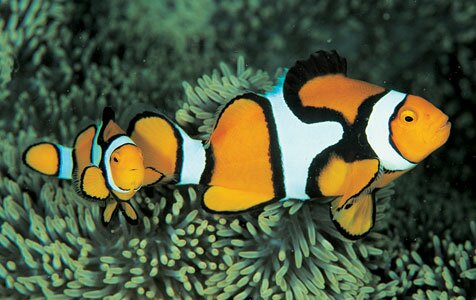Percula Clownfish
From Microcosm Aquarium Explorer
Overview
An exquisite fish that is a joy to keep. Very similar to the Ocellaris Clownfish, A. ocellaris, although the white body bars in Perculas are often edged in jet black.
Tends to be more aggressive toward conspecifics than A. ocellaris. House singly or in pairs; two juveniles will usually mature into a mated pair. Adult females are larger than their mates (also true for A. ocellaris).
Captive-bred stock is readily available and superior to wild clownfishes. See Wild-caught Clownfishes (Anemonefishes).
Family: Pomacentridae
Other common name(s):
- Clown Anemonefish
- Perc
- Orange Anemonefish
Native range:
- Western Pacific
- Queensland, Australia
- Papua New Guinea
- Solomon Islands
- Vanuatu
Habitat: n the wild, it is found with a host sea anemone:
- Magnificent Sea Anemone, Heteractis magnifica
- Leathery Sea Anemone, Heteractis crispa
- Giant Carpet Anemone, Stichodactyla gigantea
Maximum length: 11 cm (4 in)
Minimum aquarium size: 38 L (10 gal)
Water: Marine 24 °C (75 °F) - 28 °C (82 °F)
General swimming level: Near substrate.
Feeding
Varied diet, including meaty food items, such as frozen mysid shrimp, vitamin-enriched brine shrimp, and finely chopped table shrimp, as well as frozen preparations for herbivores. Color enhancing rations fed regularly will help bring out its most-vibrant colors. Feed at least 2 times a day.
Aquarium Compatibility
Peaceful and deal for the reef aquarium. An occasional specimen may wallow in the polyps of a large-polyped stony coral, causing them to retract in irritation.
Breeding/Propagation
Demersal (on or near the bottom) spawners that tend and protect their broods. Clownfish larvae are large and easily raised, compared to most marine aquarium fishes.
Notes
This is one of the more passive clownfishes. Although it is best kept in pairs, if you purchase two juveniles, one will transform into a female, while a subordinate individual will become a male. They rarely bother other clownfish, but are often the target of more belligerent relatives. The Ocellaris Clownfish is also harmless toward non-related fishes and invertebrates, making it one of the best clownfishes for the community aquarium or nano-reef.









